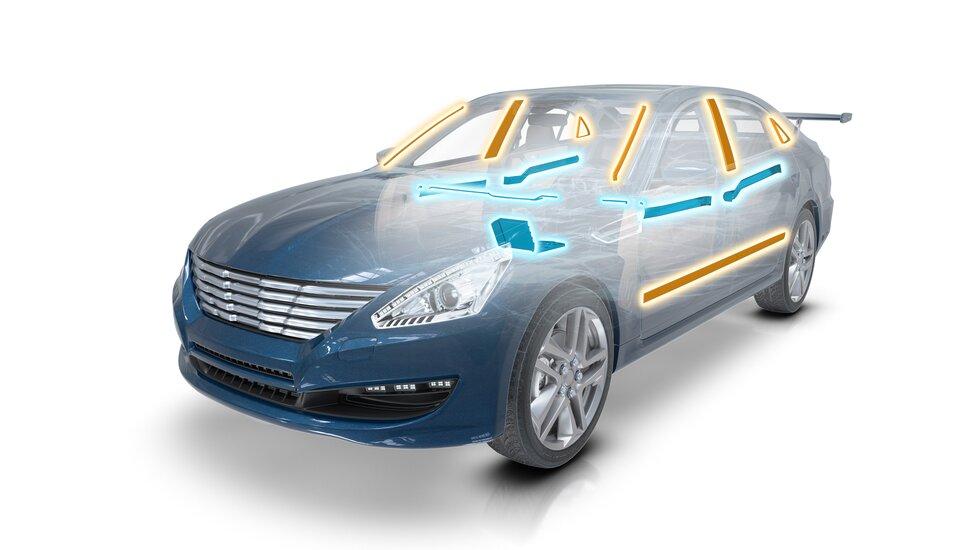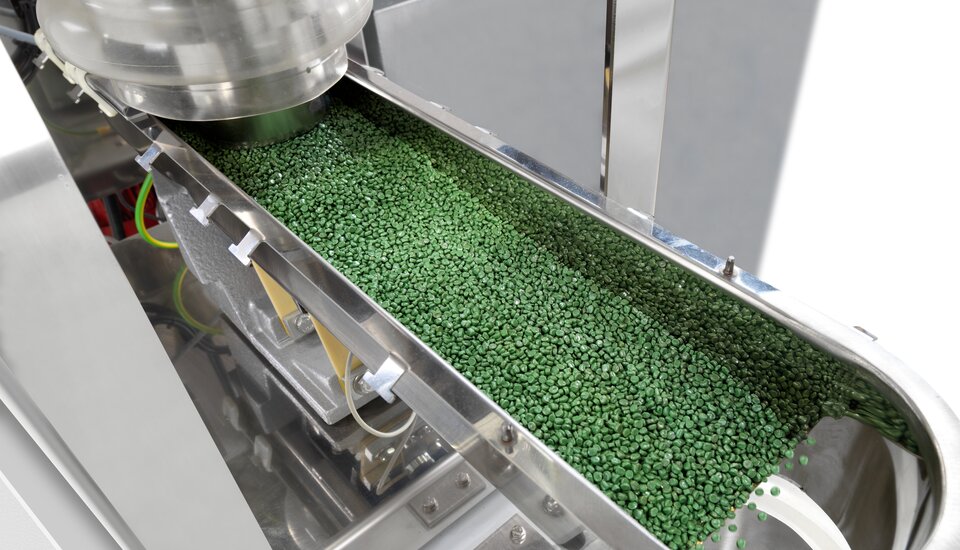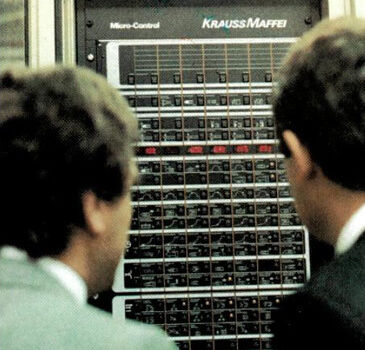
Trendgineering
Opening the doors to success
| Petra Rehmet
A KraussMaffei SpinForm machine recently fabricated its 20 millionth door lock housing
Long-running projects still exist—particularly when non-visible parts are installed in multiple vehicle models. Automotive specialist SuK Kunststofftechnik GmbH has produced 50,000 door lock housings per week for PSA since 2011. Since then, a SpinForm swivel plate machine from KraussMaffei and the corresponding molds have been running in three-shift operation.
Rarely do you think about what is inside a car door. You just see aesthetically pleasing design from both sides. For the clamping mechanism to work continuously, it must have a stable and dense housing, for example made of PP and TPE. SuK Kunststofftechnik GmbH in Kierspe, Germany, has specialized in multi-component applications and, as a system provider, supplies the complete package from design engineering to the finished component. Managing Director Sven Wieland says, "Some 85 percent of our articles go to the automotive industry, with an additional pillar being the electrical/household appliances industry, for which we also manufacture visible parts. This way, with 110 employees as of 2018, we earn annual sales of 25.5 million euros and process approximately 2,900 tons of plastic a year."
50,000 door lock housings a week
A marathon project is responsible for a major contribution: for eight years now without interruption, 50,000 pieces of the door lock housing for PSA have come off the belt each week—approximately 20 million to date. Right-hand drive, left-hand drive, front, rear, with or without child safety feature: two identical 4+4 molds with interchangeable inserts manufacture a total of ten variants. The housing color in gray, white or black designates the function of the lock. The molded-on seal made of TPE with a weight of approximately 1g requires a high injection accuracy, which the in-line injection unit already ensures in standard models through direct and central power transmission to the screw without side-mounted cylinders. The seal clings to the substrate made of 34 g fiberglass-reinforced PP (GF 20). Purging it completely was the biggest challenge of the project.

Successful long-term project:
for eight years now without interruption, 50,000 pieces of the door lock housing for PSA have been coming off the belt each week at SuK. The molded-on seal made of TPE with a weight of approximately 1g requires particularly high injection accuracy
During a direct injection, the gate point would have impaired the sealing function. Therefore, a decision was made to use a cold-runner sub-distributor. The long flow path was covered using a 2-cavity injection system. This is supplemented by two stop buffers for the door lever made of TPE with direct injection. For four cavities, this results in a 16-cavity cascade.
This all takes place in a swivel plate stack mold that runs on a CX 300 SpinForm machine from KraussMaffei. The injection units are opposite each other in the machine axis. Between them is the spin unit with a middle platen that contains media connections for oil and water as well as side-mounted ejector cylinders.


At the same time, the main injection unit on the fixed side injects the housing body and, on the moving side, applies the seal to the most recently produced housing. Because TPE is compressible, it is particularly advantageous that even the auxiliary injection unit has short melting paths without deflections. This can be implemented only using a two-platen machine without toggle, because in this machine, the second injection unit is directly downline of the mold clamping platen, just like the first unit. The 180° rotation of the spin unit is servo-electric by default, which results in high positioning accuracy with optimum dynamics with the least energy requirements. An electrically operated rotation can result in up to 25% lower energy consumption for the complete machine.
High degree of automation of almost 100 percent
For the 180° rotation, the mold briefly stops at 90° so that the finished component can be removed from the side. This clever feature means that the mold parting lines do not have to be separated and no additional rotation and folding of the gripper is needed. This requires a cycle-through rotation in one direction that makes a rotary transmission feedthrough necessary. A robot then cuts off the sprue with cold-runner sub-distributor and guides the component to the 100-percent inspection. Here, cameras inspect the dimensions of the rigid component and the geometry of the sealing. The latter must be executed with high precision so that the housing will function reliably later. For low-viscosity TPE, it is particularly important to watch out for any unwanted flashing at the mold parting line.
The high degree of automation—almost 100 percent—helps SuK survive against the competition from low-wage countries and the Kierspe facility supplies European OEMs and Tier1 and Tier2 companies. There is also a plant in Romania that was built at the request of a major customer, which supplies it with orders.
Geared for growth
The continuous growth of SuK began with Martin Witulski, who in 2007, took over the company that was founded as Schütrumpf & Kückelhaus in 1973—back when it had 20 employees and annual sales of two million euros. Just seven years later, the number of employees had grown to 110 and sales increased many times over, to 17 million euros. In 2014, the company was sold to the Luxshare Precision Industry group. Since 2017, Sven Wieland has been the company's Managing Director.
A critical success factor has been the strategy of supplying its customers with everything from a single source. The company has made a name for itself particularly in the multi-component area and in special applications such as insert molding. Physical foaming is another of the applications in which the Kierspe-based company is a pioneer. Witulski, who had a different position at the time, was the first to introduce the Trexel MuCell process in Europe—also on a KraussMaffei machine.
The production depth at SuK ranges from Design Engineering and in-house moldmaking (specializing in silicone and prototype molds, fine-tuning, service and reconfiguration), part manufacturing and finishing all the way to component assembly.

A successful team (from left to right):
Andreas Born (Sales Manager, KraussMaffei), Kyriakos Schoinas (Head of Production, SuK), Sven Wieland (Managing Director, SuK) and Andreas Handschke, Product and Technology Manager KraussMaffei
The shortage of skilled workers is very much present in Germany's Sauerland, the company's home region. SuK makes sure to keep loyal, proven employees on staff, and its shift models take the staff's family and health conditions into account. Training programs provide opportunity for advancement and it is a good indicator of the employees' loyalty that many skilled workers who trained at the company are in management positions today.
This smooth-running team also makes it possible to conquer new manufacturing areas such as integration of electronics into the component. If strip conductors, resistors and switches are overmolded, designers obtain much greater design freedom for features such as the ambient lighting in the auto interior. The SuK team are experts at automated manufacturing of such complex electronic components—and while they are at it, they keep thinking about what else is possible by combining metal, plastic and electricity.

In use around the clock:
The CX 300 SpinForm swivel plate machine from KraussMaffei features outstandingly high precision and machine availability
A feature that is not stylish, but still indispensable, is the fabrication of cables, i.e. attaching plug elements to a piece of cable. SuK has earned a great deal of the specialized knowledge in this field and produces the metal parts of the plug as scrap webs, which are initially pre-punched and pre-bent. Only in the injection mold do the final shaping and bonding of metal and cable by an injection-molded plug take place. Activities such as these help the company to have a better industry mix and pursue the company's strategy of continuous evolution.
KraussMaffei, the most comprehensive manufacturer of machines for plastics processing, plays a crucial role in this.
Just as the companies joined to develop the successful million concept for manufacturing door locks, additional challenging projects are sure to follow in the future.
Contact
andreas.handschke@kraussmaffei.com















